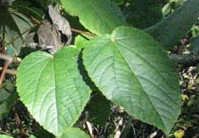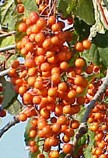 This unusual deciduous tree is a native of China, Japan, and Korea, and is noteworthy for its leaves and fruits. The heart-shaped leaves are large, up to 12” across, are borne on pinkish petioles, and flutter from horizontal branches. Bronze at first, they turn dark green above and lighter green below in the summer and persist into the fall without change in color. In spring or early summer long spikes of fragrant, yellowish-green male and female flowers are produced on different trees. In the fall, female flowers produce a show of handsome red berries if pollinated by male flowers of nearby trees. The berries persist into winter and are attractive to birds. There is no way of knowing the gender of a particular tree until it flowers in about 20 years but one male is sufficient to pollinate many females in the area. The smooth light gray bark is attractive and adds to the winter garden. Igiri is not well know and may be difficult to find but is worth growing for its beautiful leaves and berries. It is easy to grow, tolerant of wind, heat, and drought, and has no significant pest or disease problems.
This unusual deciduous tree is a native of China, Japan, and Korea, and is noteworthy for its leaves and fruits. The heart-shaped leaves are large, up to 12” across, are borne on pinkish petioles, and flutter from horizontal branches. Bronze at first, they turn dark green above and lighter green below in the summer and persist into the fall without change in color. In spring or early summer long spikes of fragrant, yellowish-green male and female flowers are produced on different trees. In the fall, female flowers produce a show of handsome red berries if pollinated by male flowers of nearby trees. The berries persist into winter and are attractive to birds. There is no way of knowing the gender of a particular tree until it flowers in about 20 years but one male is sufficient to pollinate many females in the area. The smooth light gray bark is attractive and adds to the winter garden. Igiri is not well know and may be difficult to find but is worth growing for its beautiful leaves and berries. It is easy to grow, tolerant of wind, heat, and drought, and has no significant pest or disease problems.
Type: Deciduous
Outstanding Features: Leaves; fruit
Form: Broadly pyramidal
Growth Rate: Rapid
 Bloom: Fragrant, yellowish-green male and female flowers in borne in panicles on different trees in spring or early summer; clusters of berries ripen to red in fall.
Bloom: Fragrant, yellowish-green male and female flowers in borne in panicles on different trees in spring or early summer; clusters of berries ripen to red in fall.
Size: 50-60’ H x 25-40’ W
Light: Full sun, partial shade
Soil: Fertile, moist, well-drained
Hardiness: Zones 5-9
Care: Low maintenance
Pests and Diseases: None of significance
Propagation: Seed; cuttings.
